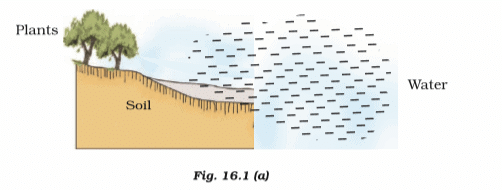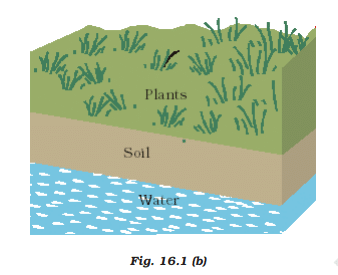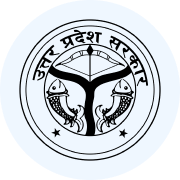NCERT Exemplar: Sustainable Management of Natural Resources | Science for Super TET PDF Download
Multiple Choice Questions
1. From the list given below to pick the item that is not a natural resource
(a) Soil
(b) Water
(c) Electricity
(d) Air
Ans: (c)
Explanation: Soil, water and air are natural resources whereas electricity is produced by humans by transformation of different sources of energy.
Q.2. The most rapidly dwindling natural resource in the world is
(a) Water
(b) Forests
(c) Wind
(d) Sunlight
Ans: (b)
Explanation: Water, wind and sunlight are non-exhaustible resources. Forests are depleting due to human activities.
Q.3. The most appropriate definition of a natural resource is that it is a substance/commodity that is
(a) Present only on land
(b) A gift of nature which is very useful to mankind
(c) A man-made substance placed in nature
(d) Available only in the forest
Ans: (b)
Explanation: Natural resource is present everywhere on earth hence option a) and d) are wrong. Natural resource are not man-made hence option d) is wrong.
Q.4. The main cause for abundant coliform bacteria in the river Ganga is
(a) Disposal of unburnt corpses into water
(b) Discharge of effluents from electroplating industries
(c) Washing of clothes
(d) Immersion of ashes
Ans: (a)
Explanation: Coliforms are mainly present in human excreta. Hence unburnt corpses are the sources of coliform which pollute Ganga river water.
Q.5. The pH of water sample collected from a river was found to be acidic in the range of 3.5 – 4.5, on the banks of the river were several factories that were discharging effluents into the river. The effluents of which one of the following factories is the most likely cause for lowering the pH of river water?
(a) Soap and detergent factory
(b) Lead battery manufacturing factory
(c) Plastic cup manufacturing factory
(d) Alcohol distillery
Ans: (d)
Explanation: Fermentation results in the production of lactic acid and alcohol. Alcohol oxidizes to get converted into ethanoic acid. This will decrease the pH of river water.
Q.6. The pH range most conducive for life of freshwater plants and animals is
(a) 6.5 – 7.5
(b) 2.0 – 3.5
(c) 3.5 – 5.0
(d) 9.0 – 10.5
Ans: (a)
Explanation: Neutral pH is the most conducive for life of freshwater plants and animals. Hence the answer is (a) 6.5 – 7.5
Q.7. The three R’s that will help us to conserve natural resources for long term use are
(a) Recycle, regenerate, reuse
(b) Reduce, regenerate, reuse
(c) Reduce, reuse, redistribute
(d) Reduce, recycle, reuse
Ans: (d)
Q.8. Given below are a few statements related to biodiversity. Pick those that correctly describes the concept of biodiversity
(i) Biodiversity refers to the different species of flora and fauna present in an area
(ii) Biodiversity refers to only the flora of a given area
(iii)Biodiversity is greater in a forest
(iv) Biodiversity refers to the total number of individuals of a particular species living in an area
(a) (i) and (ii)
(b) (ii) and (iv)
(c) (i) and (iii)
(d) (ii) and (iii)
Ans: (c)
Explanation: Option ii) and iv) are wrong statements because Biodiversity includes flora and fauna and biodiversity does not describe just one species.
Q.9. Among the statements given below to select the ones that correctly describe the concept of sustainable development
(i) Planned growth with minimum damage to the environment
(ii) Growth irrespective of the extent of damage caused to the environment
(iii) Stopping all developmental work to conserve the environment
(iv) Growth that is acceptable to all the stakeholders
(a) (i) and (iv)
(b) (ii) and (iii)
(c) (ii) and (iv)
(d) (iii) only
Ans: (a)
Explanation: Growth should not be at the expense of the environment. Human growth is equally important hence option ii) and iii) are wrong statements.
Q.10. In our country, vast tracts of forests are cleared and a single species of plant is cultivated. This practice promotes
(a) Biodiversity in the area
(b) Monoculture in the area
(c) Growth of natural forest
(d) Preserves the natural ecosystem in the area
Ans: (b)
Q.11. A successful forest conservation strategy should involve
(a) Protection of animals at the highest trophic level
(b) Protection of only consumers
(c) Protection of only herbivores
(d) Comprehensive programme to protect all the physical and biological components
Ans: (d)
Explanation: Balance in the biotic and abiotic community is very essential in the conservation of forests hence option d) is the right answer.
Q.12. The important message conveyed by the ‘Chipko Movement’ is
(a) To involve the community in forest conservation efforts
(b) To ignore the community in forest conservation efforts
(c) To cut down forest trees for developmental activities
(d) Government agencies have the unquestionable right to order the destruction of trees in forests
Ans: (a)
Q.13. In our country, there are attempts to increase the height of several existing dams like Tehri and Almati, dams across Narmada. Choose the correct statements among the following that are a consequence of raising the height of dams
(i) Terrestrial flora and fauna of the area is destroyed completely
(ii) Dislocation of people and domestic animals living in the area
(iii) Valuable agricultural land may be permanently lost
(iv) It will generate permanent employment for people
(a) (i) and (ii)
(b) (i), (ii) and (iii)
(c) (ii) and (iv)
(d) (i), (iii) and (iv)
Ans: (d)
Q.14. Expand the abbreviation GAP
(a) Governmental Agency for Pollution Control
(b) Gross Assimilation by Photosynthesis
(c) Ganga Action Plan
(d) Governmental Agency for Animal Protection
Ans: (c)
Q.15. Select the incorrect statement
(a) Economic development is linked to environmental conservation
(b) Sustainable development encourages development for current generation and conservation of resources for future generations
(c) Sustainable development does not consider the viewpoints of stakeholders
(d) Sustainable development is a long-planned and persistent development
Ans: (c)
Explanation: Involvement of all the stakeholders is essential for the sustainable development of any programme hence option c) is a wrong statement.
Q.16. Which of the following is not a natural resource?
(a) Mango tree
(b) Snake
(c) Wind
(d) Wooden house
Ans: (d)
Explanation: Mango tree, Snake and wind are natural resources whereas wooden house is manmade.
Q.17. Select the wrong statement
(a) Forests provide a variety of products
(b) Forests have greater plant diversity
(c) Forests do not conserve soil
(d) Forests conserve water
Ans: (c)
Explanation: Forest prevent soil erosion, forest adds fertility to the soil by adding hums, hence they help conserve the soil and its fertility.
Q.18. Arabari forests of Bengal is dominated by
(a) Teak
(b) Sal
(c) Bamboo
(d) Mangroove
Ans: (b)
Q.19. Groundwater will not be depleted due to
(a) Afforestation
(b) Thermal power plants
(c) Loss of forest, and decreased rainfall
(d) cropping of high water demanding crops
Ans: (b)
Explanation: Depletion of groundwater has nothing to do with thermal power plants whereas afforestation lead with destruction of seepage and water and decrease in rainfall also affect the groundwater level.
Q.20. Opposition to the construction of large dams is due to
(a) Social reasons
(b) Economic reasons
(c) Environmental reasons
(d) All the above
Ans: (d)
Explanation: Destruction of an ecosystem near the dam is an environmental reason. Relocation of people is a social reason. Agricultural land and employment is affected is economical reasons.
Q.21. Khadins, Bundhis, Ahars and Kattas are ancient structures that are examples for
(a) Grain storage
(b) Wood storage
(c) Water harvesting
(d) Soil conservation
Ans: (c)
Q.22. Pick the right combination of terms which has no fossil fuel.
(a) Wind, ocean and coal
(b) Kerosene, wind and tide
(c) Wind, wood, sun
(d) Petroleum, wood, sun
Ans: (c)
Explanation: Option a) has coal, option b) has kerosene, option d) has petroleum which are fossil fuels hence the answer is (c) Wind, wood, sun.
Q.23. Select the eco-friendly activity among the following
(a) Using a car for transportation
(b) Using polybags for shopping
(c) Using dyes for colouring clothes
(d) Using windmills to generate power for irrigation
Ans: (d)
Explanation: Using a car for transportation, Using polybags and dyes for colouring clothes increases the environment hence they are not ecofriendly.
Q.24. It is important to make small check dams across the flooded gullies because they
(i) Hold water for irrigation
(ii) Hold water and prevent soil erosion
(iii) Recharge groundwater
(iv) Hold water permanently
(a) (i) and (iv)
(b) (ii) and (iii)
(c) (iii) and (iv)
(d) (ii) and (iv)
Ans: (b)
Explanation: Check dams helps in preventing soil erosion. By holding the water check dams also help in improvement of groundwater level.
Short Answer Questions
Q.25. Prepare a list of five items that you use daily in the school. Identify from the list such items that can be recycled.
Solution: Paper, rexin bag, blade, pen, plastic box, scale, eraser, compass and dividers (metallic), steel lunch box, steel spoon.
Paper, blade, plastic box, eraser, compass, steel lunch box and steel spoon can be recycled
Q.26. List two advantages associated with water harvesting at the community level.
Solution: Advantages associated with water harvesting at the community level are as follows
- Water harvesting increases the level of groundwater.
- Water harvesting keeps the water on the top layer of soil and thereby reduces the loss of water by evaporation.
Q.27. In a village in Karnataka, people started cultivating crops all around a lake which was always filled with water. They added fertilisers to their field in order to enhance the yield. Soon they discovered that the waterbody was completely covered with green floating plants and fishes started dying in large numbers. Analyse the situation and give reasons for excessive growth of plants and death of fish in the lake.
Solution: During rains fertilizers used for agriculture spreads to the lakes. Fertilisers contain phosphates and nitrates by which water body became enriched with these chemicals. These chemicals promote excessive growth of aquatic plants and the surface of the water was completely covered with plants. (eutrophication)
Depletion of light in the water body and insufficient availability of dissolved oxygen and nutrients resulted in the death of fish.
Q.28. What measures would you take to conserve electricity in your house
Solution: Following are the measures to conserve electricity in your house
- Replace all the incandescent bulb by LED bulbs
- Switch off the fan and light when the room/house is vacant.
- By keeping windows open light will be allowed to enter the house thereby reducing the usage of light during day time.
- Reduce usage of Air conditioners and coolers.
Q.29. Although coal and petroleum are produced by degradation of biomass, yet we need to conserve them. Why?
Solution: We need to conserve coal and petroleum because they take millions of years to form. Usage of petroleum is more compared to the formation rate and they may get depleted. Hence it is very necessary to consume them.
Q.30. Suggest a few measures for controlling carbon dioxide levels in the atmosphere.
Solution:
- Use public vehicle to reduce the vehicle pollution.
- CNG or other clean fuels should be used.
- Manure should be prepared from garbage rather than burning it.
- Planting more trees will reduce the carbon-di-oxide level in the atmosphere.
Q.31. (a) Locate and name the water reservoirs in Figures16.1 (a) and (b).
(b) Which has an advantage over the other and why?

Solution:
- Figures16.1 (a) is a pond ecosystem and Figures16.1 (b) is an underground waterbody
- Groundwater body has more advantages than the pond ecosystem for the following reasons
Water will not evaporate
Water will not spread out to recharge wells. Provides moisture for a wide area.
Water will get contaminated from animal and human waste.
They will no breeding of insects.
Long Answer Questions
Q.32. In the context of conservation of natural resources, explain the terms reduce, recycle and reuse. From among the materials that we use in daily life, identify two materials for each category.
Solution:
Reduce
Reduction of usage of material or commodity such as e.g electricity and water
Recycle
Recycle is sending back the used good to manufacturer to use the material to produce some other byproduct.
e.g., plastic cups and buckets, glass tumbler, paper, metal objects
Reuse
Reuse is the repeated usage of the same material instead of throwing it out. e.g., used envelopes, plastic carry bags, bottles of jam.
Q.33. Prepare a list of five activities that you perform daily in which natural resources can be conserved or energy utilisation can be minimised.
Solution:
(a) Unused water in the water bottle may be used for watering plant
(b) Close all the taps before you go to sleep.
(c) Avoid using a hosepipe for watering plants
(d) Wash vehicles only when they are dirty
(e) Use fan and light only when required
(f) Use solar water heating devices
(g) Use CFL in place of conventional bulbs/tubes
Q.34. Is water conservation necessary? Give reasons.
Solution: Water is a basic necessity for all terrestrial forms of life. Life is not possible without water as it is necessary for all the life process. 3/4th of the earth is filled with water but most of it is in the form of water. Hence we cannot use that water for our livelihood. We need fresh and clean water for our survival. Less than 1% of the total water on earth is freshwater. Hence available water is very less. With the increase in population, our water needs also increase. Due to this water is overexploited and in few places, people suffer from shortage of water. Hence to save the life water conservation is necessary.
Q.35. Suggest a few useful ways of utilising wastewater.
Solution: Following are the useful ways of utilising wastewater.
(a) Wastewater can be used to recharge the groundwater
(b)Wastewater can be used for irrigation
(c) treated municipal water can be used for washing cars, watering the gardens
(d) certain pollutants in sewage water can become fertiliser for various crops.
Q.36. What is the importance of the forest as a resource?
Solution: Following are the importance of the forest as a resource.
(a) Forests provide Habitat, food, protection to wildlife.
(b) Forests help in balancing CO2 and O2 of atmosphere.
(c) Forests improves water holding capacity of soil.
(d) Forests regulates water cycle.
(e) Forests are the source for all essential commodities like fuelwood, timber pulp and paper etc.
(f) forests provides useful products like fruits, resins, gums, essential oils, bidi wrapper etc.
Q.37. Why are the Arabari forests of Bengal known to be a good example of conserved forest?
Solution: The forest department developed a strategy in which the villagers were involved in the protection of the forest. In return for the labour, the villagers were paid and also had some benefit in harvesting operations. They were allowed to collect wood and fodder on payment of nominal fee. In this way, by the active and willing participation of the local people, the sal forests of Arabari were conserved.
|
59 videos|118 docs|73 tests
|
FAQs on NCERT Exemplar: Sustainable Management of Natural Resources - Science for Super TET
| 1. What is sustainable management of natural resources? |  |
| 2. Why is sustainable management of natural resources important? |  |
| 3. What are some examples of sustainable management practices for natural resources? |  |
| 4. How can individuals contribute to sustainable management of natural resources? |  |
| 5. What are some challenges to achieving sustainable management of natural resources? |  |

|
Explore Courses for Super TET exam
|

|

















